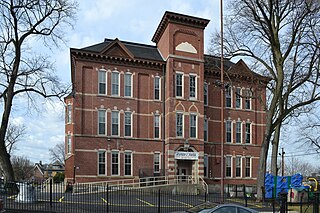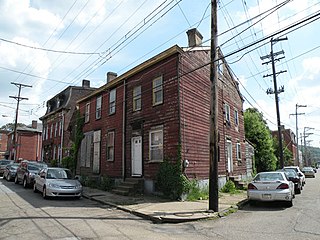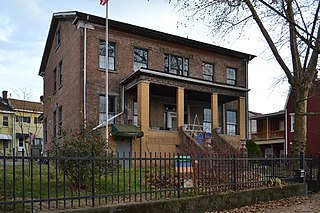
The Carnegie Library of Pittsburgh is the public library system in Pittsburgh, Pennsylvania. Its main branch is located in the Oakland neighborhood of Pittsburgh, and it has 19 branch locations throughout the city. Like hundreds of other Carnegie libraries, the construction of the main library, which opened in 1895, and several neighborhood branches, was funded by industrialist Andrew Carnegie. The Pittsburgh area houses the first branches in the United States.

Allegheny City was a municipality that existed in the U.S. state of Pennsylvania from 1788 until it was annexed by Pittsburgh in 1907. It was located north across the Allegheny River from downtown Pittsburgh, with its southwest border formed by the Ohio River, and is known today as the North Side. The city's waterfront district, along the Allegheny and Ohio rivers, became Pittsburgh's North Shore neighborhood.

Allegheny West is a historic neighborhood in Pittsburgh, Pennsylvania's North Side. The Pittsburgh Historic Review Commission voted in favor of designating the neighborhood as a city historic district in September 1989.

Lawrenceville is one of the largest neighborhood areas in Pittsburgh in the U.S. state of Pennsylvania. It is located northeast of downtown, and like many of the city's riverfront neighborhoods, it has an industrial past. The city officially divides Lawrenceville into three neighborhoods, Upper Lawrenceville, Central Lawrenceville, and Lower Lawrenceville, but these distinctions have little practical effect. Accordingly, Lawrenceville is almost universally treated as a single large neighborhood.

The Mexican War Streets, originally known as the "Buena Vista Tract," is a historic district that is located in the Central Northside neighborhood of Pittsburgh, Pennsylvania, in the United States. The district is densely filled with restored row houses, community gardens, and tree-lined streets and alleyways. The area dates to around the time of the Mexican–American War and a number of streets are named after battles and generals of the war.

The Allegheny Arsenal, established in 1814, was an important supply and manufacturing center for the Union Army during the American Civil War, and the site of the single largest civilian disaster during the war. It was located in the community of Lawrenceville, Pennsylvania, which was annexed by the city of Pittsburgh in 1868.

The O'Hara Student Center, formerly the Concordia Club, is a three-story, 18,000-square-foot (1,700 m2) building on the campus of the University of Pittsburgh on O'Hara Street in the Oakland neighborhood of Pittsburgh, Pennsylvania. It is a contributing property to the Schenley Farms National Historic District and the City of Pittsburgh Oakland Civic Center Historic District. The building was acquired by the university in mid-December, 2009. and has since been renovated to house academic and student activity programs.

The Stephen C. Foster School, also known as the Stephen C. Foster Community Center, is a historic school building in the Central Lawrenceville neighborhood of Pittsburgh, Pennsylvania. It is named for composer Stephen Foster, whose father William Barclay Foster once owned the land on which the building is located. The school opened in 1886 and operated until 1939, when its students were transferred to the new elementary wing of Arsenal Junior High School. Since 1939, the building has been used as a community center.

184 38th Street, also known as McBride Log House, was a historic log house in the Lawrenceville neighborhood of Pittsburgh, Pennsylvania. Before its demolition, it was thought to be the oldest log house in any major American city to be used as a residence.

The Walker-Ewing Log House is an historic, eighteenth century loghouse located in Collier Township, Allegheny County, Pennsylvania. Owned and managed by the Pioneers West Historical Society beginning in the 1990s, the home and land were acquired by the Allegheny Land Trust in 2020 with oversight responsibility for the building's preservation and easement given to the Western Pennsylvania Conservancy.

The Albright United Methodist Church is a disused church building at 486 S. Graham Street at the nexus of the Bloomfield, Shadyside, and Friendship neighborhoods of Pittsburgh, Pennsylvania, US. The church was designed by architect Chancey W. Hodgdon in an Eclectic, Richardson Romanesque style with prominent elements of Gothic Revival, and was built in 1905-1906.

The Carol Peterson House is located at 172 46th Street in the Lawrenceville neighborhood of Pittsburgh, Pennsylvania. The house was built in 1886–1887 in the Italianate architectural style, and is named after the architectural historian, Carol Peterson.

The Turney House is a historic house in the Lawrenceville neighborhood of Pittsburgh, Pennsylvania, and a designated Pittsburgh historic landmark. It was built circa 1851 by Lucian B. Turney, a carpenter who also served on the Lawrenceville Borough Council during the 1850s. It was also the residence of Turney's daughter Margaret, who at age 17 was one of 78 workers killed in the 1862 Allegheny Arsenal Explosion, the deadliest civilian disaster during the U.S. Civil War. After the demolition of 184 38th Street in 2011, the Turney House is the only surviving house known to be associated with a victim of the explosion. Another one of Turney's children, Olive, became a successful artist. In 1996, the house was purchased by architectural historian Carol Peterson, who restored it to a period-appropriate appearance.

Naser's Tavern is a historic building in the Lawrenceville neighborhood of Pittsburgh, Pennsylvania, and a designated Pittsburgh historic landmark. It is thought to be the oldest surviving building on Butler Street, the main commercial street in Lawrenceville. The structure was probably built by John Kingan between 1833 and 1846, as the price of the property when Kingan sold it indicates there was already a substantial building on the site. At the time, it was at the edge of the built-up area of Butler Street, which spanned approximately one block on either side of the Allegheny Arsenal. John Naser, a German immigrant, bought the property in 1846 and operated an inn and tavern there which he called "Our House". His son Charles took over the business in the 1870s and expanded the building with several additions, including a second floor which was built sometime between 1893 and 1905. The Naser family sold the building in 1943. As of 2018 it houses a branch of Pennsylvania's state-run liquor store, Fine Wine & Good Spirits.

The Lawrenceville Historic District is a U.S. historic district in Pittsburgh, Pennsylvania, which encompasses the majority of the Lawrenceville neighborhood. The historic district includes 3,217 contributing resources, many of which are rowhouses, commercial buildings, and former industrial properties built between the 1830s and early 20th century. The district was listed on the National Register of Historic Places in 2019.

The Pennsylvania National Bank Building is a historic building in the Lawrenceville neighborhood of Pittsburgh, Pennsylvania. It is located on a prominent site facing Doughboy Square, the acute intersection of Butler Street and Penn Avenue which is often considered the "entrance to Lawrenceville".

The Mowry-Addison Mansion is a historic house in the Upper Lawrenceville neighborhood of Pittsburgh, Pennsylvania, and a contributing property in the Lawrenceville Historic District. It was built in 1830–32 by Peter Mowry, a physician, and was originally part of a large estate that was subdivided into residential lots in 1872. The house is notable as a rare example of relatively well preserved Greek Revival architecture in Pittsburgh, and exemplifies the typical pattern of development in Lawrenceville in the mid to late 19th century. In 2020, the building was nominated as a Pittsburgh historic landmark by Preservation Pittsburgh, which stated that the mansion "is one of the last remaining and most significantly preserved regional ribbon farm dwellings from its period of construction."
The Abrams House was an architecturally notable residence in the Squirrel Hill neighborhood of Pittsburgh, Pennsylvania. It was built in 1979–82 and was considered Pittsburgh's earliest example of Postmodern architecture. The house was designed by postmodernist pioneer Robert Venturi, who called the design "one of the best that has come out of our office".
Two buildings in Pittsburgh were known as the United States Marine Hospital. They were part of the U.S. Marine Hospital system, which was run by the Marine Hospital Service and its successor the Public Health Service, primarily for the benefit of the civilian merchant marine. The original hospital was located in Allegheny City and was used as a Marine Hospital during 1851–1875, after which it was sold. It was demolished in the late 1880s for construction of the Ohio Connecting Railroad Bridge.


















